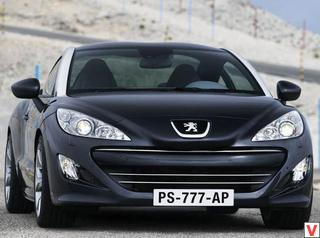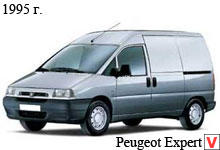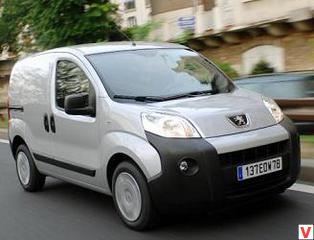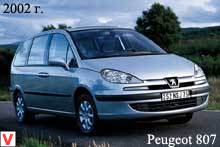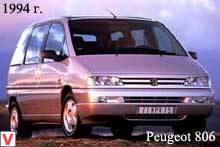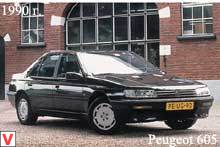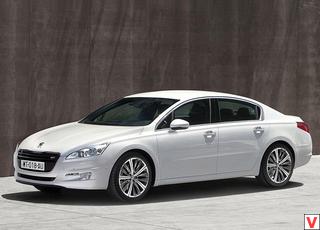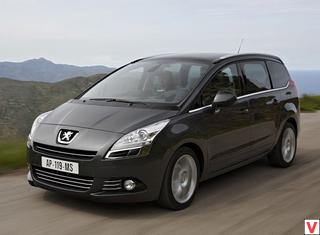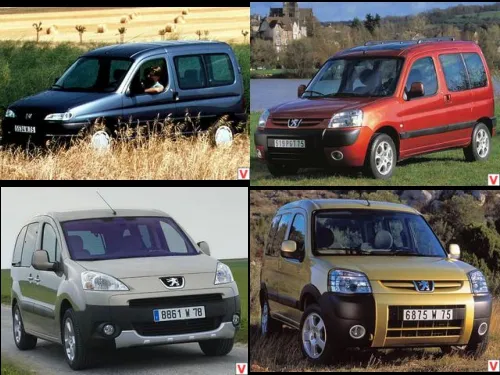
Passenger car Peugeot Partner appeared in 1997. Its uniqueness lay in the fact that with the dimensions of a car of a golf class, it had the carrying capacity of a commercial van, had a spacious five-seater cabin and a huge trunk. Structurally, the Partner of the first generation had much in common with the Peugeot 306 model, since both cars were made on the same base. If the cargo version was simply called Partner, then the passenger version received the prefix Combi. In Italy, the car was known as the Peugeot Ranch.
The first generation lasted on the conveyor without changes for six years and at the same time did not lose its relevance. The appearance of the restyled version of Peugeot Partner in 2002 only strengthened the position of this car in the market. The changes that have occurred cannot be called drastic. The body remains the same, the overall layout, too. In fact, the car just thoroughly retouched. The updated Partner has got big big-eyed headlights, a modernized false radiator grille and a modified shape of the front wings. The main element of the exterior was a pronounced "kengurin" front bumper, which on expensive versions painted in body color.
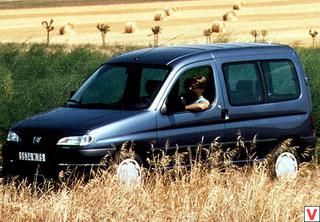
Combined headlights with smooth glass unite all front lighting devices: side lights, direction indicators, headlights and dipped beam. The enlarged wings and body mirrors, painted in body color, give perfection to the appearance of the vehicle. Peugeot Partner 2002 model year reflected the most progressive achievements of science and technology. For example, the rhythm of the wipers depends on the speed of the car, there is a system of smooth on and off lighting, adaptive power steering, air conditioning, cruise control, etc. In terms of equipment, the restyled Partner is much better than its predecessor. The basic version is equipped with airbags for the driver and front passenger.
Under the order are also offered side airbags, plus seat belts with pyrotechnic pretensioners, Isofix anchorages for child seats, an additional brake light and an automatic gasoline interruption system in the event of an accident. In the production range of Peugeot Partner there are cars with front-wheel drive and all-wheel drive. There are several versions available: a 2-seater cargo van with a carrying capacity of 600 or 800 kg, a 5-seater cargo-passenger van Combi, a 5-seater comfortable cargo-passenger van CombiSpace. The latest example of practicality and functionality. All versions when restyling got a new interior.
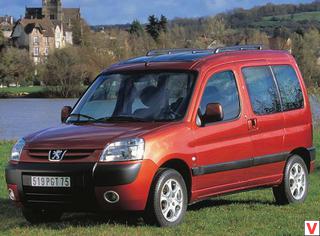
The rim of the steering wheel became more plump and softer, a new instrument panel and a center console appeared. It is noteworthy that on the more expensive versions the panel has a two-color upholstery. In the center of the dashboard is a display of electronic clocks and audio systems. It is equipped with a display, which, when the engine is started, displays information about the mileage remaining until the next maintenance, and the level of engine oil. Convenient steering wheel of reduced diameter, along with traditional levers, has remote controls for cruise control and remote control audio system.
The number of places for storing various items has increased. In addition to all the pockets and niches of the previous model, the new Partner has a drawer under the driver’s seat, as well as small caches at the feet of the rear passengers. Plus three drink can holders, a removable ashtray and a 12V socket. The dimensions of the Peugeot Partner (4.11 x 1.79 x 1.8 m) made it possible to create an excellent cabin with five full seats and plenty of luggage space.

Sliding door and folding front seat backrests provide free access to the rear seats. But access to the rear seats is carried out not only through the sliding door on the right, but also through the front doors. If you need to carry something bulky, you can fold the rear seats and you will get a luggage compartment with a flat floor of 2.8 m³. The cargo compartment is separated by a net, and it also has a curtain hiding the contents of the trunk from prying eyes. From the line of power units disappeared the weakest engine of 1.1 liter.
Now, under the hood Partner can be one of the following units: a gasoline volume of 1.4 liters or 1.6 liters, diesel volume of 1.9 l / 69 hp or a 2.0 liter HDI with 90 hp. with Common Rail fuel injection system. Impeccable behavior of the car in motion is due, in particular, the perfection of its chassis. The front axle is equipped with MacPherson struts and a stabilizer bar. The rear suspension includes two transversely located torsion bars, an anti-roll bar and inclined shock absorbers.
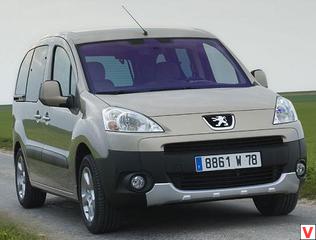
The top version of Ushuaia differs from the base version with grilles on the headlights and rear lights, increased ground clearance, protection of the engine crankcase and the limited slip differential in the front wheel drive. The latter turns Partner into a car that can drive without problems both in deep snow and on sandy beaches. The second generation (in the back of the B9) was officially introduced in January 2008. The car is significantly different from its predecessor in all respects, and style, and technical equipment. The second-generation passenger version was named Partner Tepee.
The second generation car is based on the so-called universal platform 2 of the concern “PSA” for small and middle-class cars, which, in particular, formed the basis of the passenger models Peugeot 308 and Citroen C4 Picasso. Compared with the previous generation, it has increased markedly in size. In the basic version, it is 24 cm longer and 13 cm wider, despite the fact that the wheelbase has grown by only 4 cm. Accordingly, the weight of the car also increased by several kilograms.
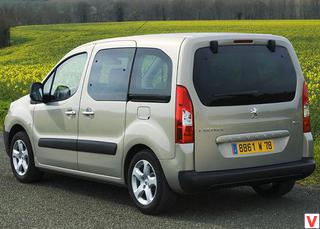
Instead of a torsion bar rear suspension, the car was equipped with a conventional beam with shock absorbers and springs, similar to that installed on passenger cars. As a result, Partner has become much more comfortable, but the cargo characteristics have decreased. However, this disadvantage is compensated by a larger cargo space than the previous generation. The total volume of the cargo compartment reached 3.3 cubic meters, and carrying capacity - up to 850 kg. Folding front seats Multi-Flex in the folded state can increase the cargo space to 3.7 m³, and loading length from 1.8 m to 3 m. The manufacturer did not stint on all sorts of clothing niches, shelves and pockets in the cab.
They are literally everywhere - above the windshield, on the front panel, in the doors and even under the front seats. Their total capacity, if you use all the options, 64.5 liters. Individual words deserve excellent insulation car. Specialists Peugeot did their best, not regretting all sorts of shielding and sound-absorbing materials in the engine compartment and the cabin, as well as special seals in the front doors. In addition, the use of thicker side windows (3.85 mm) also played a role. The 1.4-liter engine has disappeared from the line of power units.
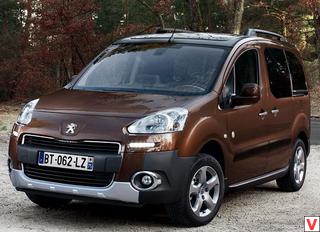
Now the weakest in the range is the 75-strong inline four-cylinder 1.6-liter turbo diesel engine with the common rail fuel injection system. In addition to it, a 90-horsepower diesel engine and a gasoline engine of the same power and volume are also offered for the cargo van. The passenger version of the Tepee, in contrast to the fellow cargo, has a longer engine range. In addition to the above, this is another 110-horsepower gasoline engine of 1.6 liters and diesel FAP of the same power and displacement. A conventionally “off-road” version of the Tepee, shod with tires of dimension 215 / 55R16, is called Outdoor and features an increased ground clearance of 10 mm and crankcase protection.
The standard model includes anti-lock brakes, emergency braking assistance, two front airbags, central locking, power windows and an audio system. The next restyling of the model was made in 2012. Peugeot Partner 2012 model range combines all the best characteristics inherent in earlier releases: capacity, economy, reliability. In addition, the restyled version is distinguished by excellent driving performance, a comfortable lounge and an interesting recognizable design. The car received a new grille and emblem, front and rear lights, rear-view mirrors and wheel covers.

Compared with previous versions, Partner 2012 has grown in length by as much as 240 mm (up to 4380 mm) and has become 80 mm wider (up to 1810 mm). The wheelbase also increased to 2730 mm. Increased and cargo compartment. The luggage compartment volume has grown by 51 liters and starts at 675 liters. If you fold the back of the front passenger and the middle one in the second row, you get an excellent compartment for transporting long-length vehicles up to 2 meters. For the convenience of loading dlinnomer glass on the back door made opening. In the Partner Tepee 2012 version, there are only two front seats, unlike previous versions.
The interior is spacious. The wheel is regulated both on a departure, and on height. Optionally installed glass roof. The list of options also includes the ESP system, which helps to get under way on the climbs, six airbags and a tire pressure monitoring system, etc. Gamma engine offers two petrol (90 and 109 hp) in volume of 1.6 liters and three diesel (75, 90, 110 hp).
All engines are paired with a five-speed manual gearbox. Powertrains have excellent economic performance (average fuel consumption in the combined cycle is within 8 liters) and modest dynamic performance.
